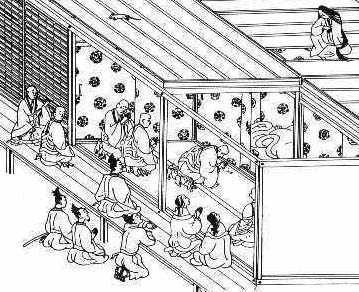Kasuga no
Daimyojin: "In
1205 and 1006, Myōe made several journeys back and forth to
Kyoto. Then, in late 1206, Go-Toba granted him land and the old
temple at Toganoo, which was then a dependency of Jingoji. Myōe
renamed the temple Kōzanji, and installed the Kasuga deity
there as the temple's local protector." R.
Tyler, The Miracles of the Kasuga Deity. New York, 1990.
rose to the roof: The
fish is "what has come up from the depths." E.
Shalit, "Will Fishes Fly in Aquarius—Or Will They Drown
in a Bucket?" San Francisco Jung Institute Library Journal.
November 2005. "It is significant that in most of the early
fish cults the central figures were female deities and the male deities
were the exception." E. Neumann, The
Origins and History of Consciousness. Princeton, NJ., 1973.
some people find: T.
Roszak, "Eco-Psychology: Jeffrey Mishlove Interviews Theodore
Roszak." Thinking Allowed Productions, 1998.
licked her: "According
to Myōe's account in the Secret
Book of Shrine Pledges, the Kasuga Deity not only emitted a
mysterious fragrance but also an otherwordly taste on its hands,
feet, and mouth. The people who were present began to lick the sumptuously
sweet flavor and fell into an ecstasy." H.
Kawai, The Buddhist Priest Myōe: A Life of Dreams. Venice,
CA., 1992.
eating disease: "This
beautiful woman who eats nothing has a big mouth on the top of her
head which devours thrity-three rice balls and three mackeral. A woman
who eats nothing is actually a woman who eats everything." H.
Kawai, The Japanese Psyche. Dallas, TX., 1988.
four types: S.
Walens, Feasting with Cannibals: An Essay on Kwakiutl Cosmology.
Princeton, NJ., 1981.
dreamed of
a fish: “(A) ninth-century tale tells how,
when the talented magnate was stopping at an inn, he was visited
in three successive dreams by a woman dressed in yellow. She identifies
herself as a resident of ‘Ch’u waters’ and begs
him to rescue her, The writer is unable to understand how he can
save her life until, at a banquet given in his honor by a local
official, he realizes that he is to have fish for dinner, He asks
a flunkey about it, and is informed that a yellow-scaled fish had
been netted the previous day. Its head has already been cut off,
and it is ready to serve. Liu Tsung-yüan orders the fish be
thrown back into the Kiany. That night the woman appears in a final
dream---headless." E.H. Schafer, The
Divine Woman: Dragon Ladies and Rain Maidens. San Francisco,
CA., 1980.
his anima: "Myoe's
inner struggle was to fulfill his sexuality as a male without violating
the Buddhist precepts, or to use Jung's terminology, to elevate the
biological anima to a spiritual anima by way of a romantic anima" S.
Nagatomo, Review of Hanao Kawai's, The Buddhist Priest Myōe:
A Life of Dreams. (Philosophy East & West, July 1994.)
no salient self: "She
was completely transparent, and [watching her] was like watching the
lines in a crystal" R. Tyler, Ibid. "Of the two superior
types of spiritual being the most important and powerful are the kami. These
numinous presences have been the principal objects of worship in the
Shinto cult since pre-Buddhist times. They are difficult to describe,
because they are elusive, enigmatic, heterogeneous. They are best understood
perhaps as hierophanies, manifestations of sacred power in the human
world." C. Blacker, The Catalpa
Bow: A Study of Shamanistic Practices in Japan. London, 1975. "Never
before have I shown my true form this way and come down into human
presence,' she said, 'and I never will again.'" R.
Tyler, Ibid. |
